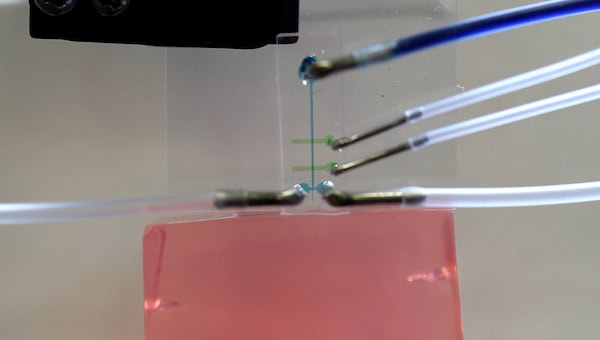
[Image above] Rice University researchers have developed a method using microfluidics to implant conductive, thin, flexible fibers into brain tissue. Implanted wires could help patients with neurological diseases and help scientists explore cognitive processes and develop implants to help people to see, to hear and to control artificial limbs. Credit: Robinson Lab/Rice University
Carbon nanotubes have been making headlines here on Ceramic Tech Today in the past couple of years—especially in the areas of high-powered transistors, desalination, electrical energy, and lead detection.
Scientists at Rice University have recently developed a device that can insert flexible carbon nanotube fibers into the brain through a path of fast-moving fluids—with the purpose of recording neural activity. Their method could replace current procedures where hard wires or other biodegradable objects are inserted into the brain—procedures which could possibly injure or damage sensitive brain tissue.
The specially designed device applies tension to force fluid to flow around a thin fiber electrode. As the fluid quickly moves, it pulls the electrode through to the tissue. After entering the tissue, the flexible wire stays completely straight.
Jacob Robinson, assistant professor of electrical and computer engineering and one of the project leaders uses a food analogy to describe the process. “The electrode is like a cooked noodle that you’re trying to put into a bowl of Jell-O,” he explains in a Rice University news release. “By itself, it doesn’t work. But if you put that noodle under running water, the water pulls the noodle straight.”
Unlike other methods that deliver wires into the brain, the Rice team’s device can insert flexible electrodes deep into tissue without increasing the thickness and stiffness of the electrode, aggravating neural damage during implantation, or damaging brain tissue, according to the paper’s abstract.
The researchers used agarose gel to represent an actual brain. Although the fluid moves the fiber through the tissue, none of the fluid actually penetrates the “brain” tissue.

Fast-moving fluid pulls a fiber through a microfluidic device to be inserted into brain tissue. Credit: Robinson Lab/Rice University
“Once the wire is in the tissue, it’s in an elastic matrix, supported all around by the gel material,” Matteo Pasquali, chemist, co-author of the paper, and whose lab created a custom fiber for the research project. “It’s supported laterally, so the wire can’t easily buckle.”
Carbon nanotubes are conductive, which makes them perfect for connecting with neurons. The problem is that they will conduct electrons on all sides—which is ineffective in communicating and recording brain activity. According to assistant professor of electrical and computer engineering Caleb Kemere, carbon nanotube fibers have to be insulated around everywhere but the tip—so they can block ions from penetrating the sides of the fiber.
The device could help researchers learn more about cognitive processes as well as provide new ways to allow patients to see, hear, or control artificial limbs, according to the release. The researchers say their device could be scaled to deliver multiple electrodes that would make it easier to embed implants.
“As deep brain stimulation (DBS) is one of the few current invasive brain disease therapies, we always think about it whenever we develop new electrode delivery techniques,” Kemere wrote in an email when asked about possible applications for DBS. “In their current form, our microfluidic delivery system is most suited to cortical electrodes—which might be used for brain machine interfaces in patients with tetraplegia, or to restore sight in blind patients. In these scenarios, scaling to large numbers of electrodes would of course, be critical, and that is one of our current focus areas.”
The paper, published in Nano Letters is “Fluidic Microactuation of Flexible Electrodes for Neural Recording” (DOI: 0.1021/acs.nanolett.7b04184).
Watch the videos below to see how their device works.

Credit: Rice University
Did you find this article interesting? Subscribe to the Ceramic Tech Today newsletter to continue to read more articles about the latest news in the ceramic and glass industry! Visit this link to get started.
Author
Faye Oney
CTT Categories
- Basic Science
- Biomaterials & Medical
- Electronics
- Nanomaterials


